Coat of arms of Saxony
| Coat of arms of Saxony | ||
|---|---|---|
Shield Barry of ten sable and or, a crancelin vert | | |
The
The
History
The shield "
From about 1260, the
When upon the German reunification the Free State of Saxony was re-established, the coat of arms was formally confirmed in 1991:
The Landtag of Saxony state parliament has passed on 25 October 1991 the following law:
§ 1 (1) The lesser coat-of-arms of the Free State of Saxony shows an escutcheon bendy of nine pieces black and gold, a green rue-crown bendwise. (2) A greater coat-of-arms of the Free State of Saxony can be determined by a special law.
§ 2 For the rendering of the coat-of-arms the patterns, which are attached to this law as appendix, are authoritative. The coloured patterns are deposited in the Main Public Record Office of Saxony.
§ 3 The regulations necessary for the implementation of this law are issued by the State Government. It can pass on this authority.
§ 4 This law comes into force the day after its proclamation.
The preceding law is executed herewith and is to be proclaimed.
— Prof. Dr. Kurt Biedenkopf (Minister President), Steffen Heitmann (State Minister of Justice), Law relating to the coat-of-arms of the Free State of Saxony of 18 November 1991, (Saxon Law and Official Gazette 1991, p. 383-385), Dresden, 18 November 1991.[3]
The Constitution of the Free State of Saxony adopted by the Landtag on 26 May 1992 stated the country flag displays in a ninefold partitioned field of Black and Gold a right diagonal green crancelin.[4]
Galleries
Previous versions
-
Widukind's White Steed as ensign of theElectorate of Hanover
-
Counts of Aschersleben (Ascharia), ancestors of the House of Ascania, from about 1000
-
Counts of Ballenstedt, ancestors of the House of Ascania, from about 1000
-
heraldic
-
Red Eagle used from 1170 by the Ascanian margrave Otto I of Brandenburg, son of Albert the Bear, probably derived from a hereditary family ensign since around 900
-
Saxe-Lauenburg (1296–1803; 1814–1876)
-
Arch-Marshal and the green crancelin.
-
Meissen(1498-1510)
-
Royal coat of arms of the Polish–Lithuanian Commonwealth, ruled in personal union by the Saxon electors Augustus the Strong (1697–1706) and Frederick Augustus II (1734–1763)
-
Coat of arms of Elector Frederick Augustus II, King of Poland, as Imperial vicar
-
Kingdom of Saxony (1806–1918)
-
Coat of Arms of the Napoleonic Duchy of Warsaw (1807–1815), ruled in personal union by King Frederick Augustus I of Saxony
-
Prussian Province of Saxony (1816–1944)
-
Saxe-Coburg and Braganza Branch, Empire of Brazil (1822-1889)
-
Coat of Arms of Ferdinand II, King of Portugal
Ernestine duchies
-
Saxe-Weimar (1572–1809)
-
Saxe-Coburg and Gotha (1826–1918)
-
Saxe-Gotha-Altenburg (1680–1826)
-
Duchy of Saxe-Altenburg(1602–1672; 1826–1918)
-
Saxe-Merseburg (1657-1738)
-
Saxe-Weissenfels (1656–1746)
-
Saxe-Hildburghausen (1680–1826)
-
Duchy of Saxe-Weimar-Eisenach(1809–1918)
-
Duchy of Saxe-Weimar (1572–1809)/ Duchy of Saxe-Wittenberg (1296–1356) with the black-yellow imperial colored stripes and green crancelin
-
Duchy of Saxe-Coburg(1596–1633; 1680–1735)
-
Saxe-Meiningen (1680–1918)
United Kingdom
-
George V (as Duke of York)
-
George V (as Prince of Wales)
-
Edward VII (as Prince of Wales)
-
Princess Maud of Wales
-
Princess Marie of Edinburgh
-
Mary of Teck (as Princess of Wales)
-
Princess Beatrice of Saxe-Coburg and Gotha (as British Princess)
-
Alfred of Saxe-Coburg and Gotha(as British Prince)
Belgium
-
Charlotte of Belgium, Empress consort of Mexico
Bulgaria
Spain
-
Princess Beatrice of Saxe-Coburg and Gotha
(as Spanish Infanta by marriage and Duchess Consort of Galliera)
Luxembourg
-
Maurice of Nassau
Poland
Nazi Germany
-
Gau Saxony (1933–1945) none real coat of arms of Saxony due the Saxon coat of arms was unsolicited for government[5][clarification needed]
See also
- Royal Arms of England
- Coat of arms of Portugal
- Coat of arms of Belgium
- Coat of arms of Bulgaria
References
- ^ a b Freistaat Sachsen official website Archived 2013-01-22 at the Wayback Machine (in German) Accessed 2009-05-19.
- ^ a b Saxony (Germany) at Flags of the World
- ^ Flag Legislation (Saxony, Germany) Archived 2008-11-22 at the Wayback Machine
- ^ "Art.2 (3)". Archived from the original on 2011-06-17. Retrieved 2012-12-22.
- ^ Hitlers Mein Kampf: "The Saxons are so strong bastardisized"... ...."We should use the new forms of our symbols to protect the meaning of our time."









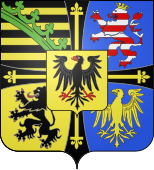












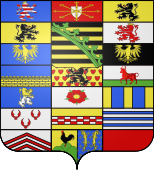





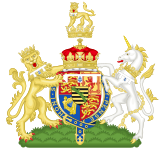
















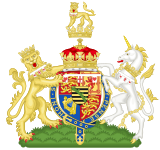



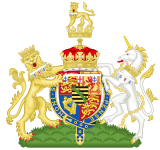

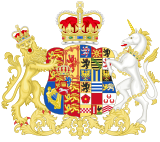
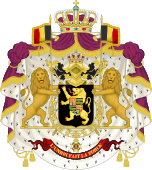


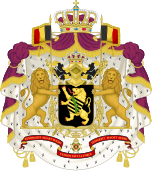















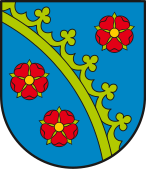
![Gau Saxony (1933–1945) none real coat of arms of Saxony due the Saxon coat of arms was unsolicited for government[5][clarification needed]](http://upload.wikimedia.org/wikipedia/commons/thumb/4/4e/Gau_Saxony_1933-1945.svg/154px-Gau_Saxony_1933-1945.svg.png)